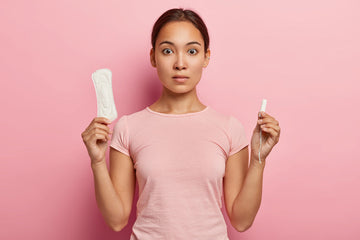The postpartum period is a crucial phase of treatment for new mothers, marked by hormonal fluctuations, physical recovery, and emotional adjustments. During this time, one of the most common yet often overlooked problems is skin inflammation, especially in the intimate area. It ranges from itching and rash to burning sensations, typically resulting from prolonged use of responses to pads, friction, or synthetic materials. While many women use sanitary napkins regularly after giving birth, they are not designed for the maternal recovery period. So, it can be switched to a maternity pad, which is mainly designed for Post-delivery care, helping to reduce or prevent skin irritation.
What is Postpartum Skin Irritation?
Post-delivery skin irritation is a common difficulty many women face after childbirth; however, it is frequently left out. As the body heals and adjusts, the intimate area can become sensitive due to regular pad use, moisture, and friction. This can lead to discomfort, such as itching, redness, or rashes, which can interfere with day-to-day activities and slow down recovery. Although regular, this inflammation shouldn't be overlooked, as the right care and proper hygiene products can significantly ease the pain and support recovery.
What are The Causes of Irritation After Delivery?
Hormonal Changes and Sweating
After childbirth, hormonal fluctuations have an effect on the skin’s balance, making it extra reactive and sensitive. This high sensitivity can cause inflammation or redness even from mild touch, especially inside the intimate area, where restoration continues to be ongoing. New mothers might also experience itching or burning sensations that weren’t present earlier because of this hormonal shift.
Synthetic Materials in Regular Pads
Prolonged use of pads traps moisture and warmth, creating a hot, damp environment. This encourages bacterial growth and will increase friction, skin irritation, chafing, or maybe infections. Frequent pad changes and breathable substances are crucial to keep the area dry and reduce the probability of soreness during the Maternal recovery period.
Friction and Poor Airflow
Standard sanitary pads frequently include plastic-based surfaces that are less breathable and tough on the skin. These materials can rub against delicate postpartum skin, causing friction and discomfort, especially during movement. This steady infection can also cause rashes or worse, existing sensitivity in areas recovering from stitches or swelling.
Prolonged Dampness
Many commercial pads contain added fragrances or chemical compounds meant to mask smell or enhance appearance. However, these components can irritate touchy skin, especially in new mothers. They can also cause hypersensitive reactions such as itching, redness, or burning. Choosing fragrance-free, hypoallergenic pads is safer and more suitable for the Maternal recovery period care.
Why Regular Pads May Not Be Enough
Regular sanitary pads are made for menstrual flow, not for the heavier, longer-lasting postpartum bleeding known as lochia. As a result, they may not provide the absorbency or comfort needed during recovery. These pads often have synthetic layers that trap heat and moisture, creating a damp environment that can irritate sensitive skin. Their bulky or rough texture can cause friction, leading to rashes or itching. Many new mothers report discomfort and skin issues when using regular pads after childbirth, making them a less suitable option for use during the postpartum period.
What Makes Maternity Pads Different?
Maternity pads are specifically designed for an irritation-free experience for new mothers. offering enhanced protection and comfort compared to regular pads. They are large, highly absorbent, and gentle on sensitive skin, ideal for dealing with heavy lochia flow. Most are breathable and fragrance-free, reducing the danger of irritation.
When choosing maternity pads, look for a gentle, cottony top sheet, leak-proof absorbency, and dermatologically tested ingredients. Avoid pads with harsh chemical substances or synthetic fragrances. Some alternatives are plant-based, rash-free, and provide natural, skin-safe protection. These features support recovery and maintain hygiene throughout the delicate Post-delivery recovery period.
Features to Look for in Maternity Pads
When selecting maternity pads, look for those that offer comfort and skin protection. A soft cotton top sheet calms sensitive skin, and the absence of synthetic aromas and harsh chemical substances reduces the risk of inflammation. Bottom Leak-proof breathable sheet, high-exploiting dryness and safety with backing, and breathable, dermatologically tested substances help preserve hygiene and protect you from rashes during the post-delivery recovery period.
When Should You Switch to Maternity Pads?
1. Immediately After Delivery (Vaginal or C-Section)
Right after childbirth, the body expels lochia, a heavy and continuous flow that lasts for weeks. Maternity pads are specifically designed for this stage, providing enhanced absorbency, softness, and comfort. Whether you had a vaginal birth or C-section, switching immediately ensures hygiene, protects healing areas, and prevents irritation from using pads that aren’t built for after-delivery needs.
2. If Regular Pads Feel Rough or Cause Burning
If regular pads feel tough, itchy, or cause a burning sensation, it’s a sign that they may no longer be suitable for your post-delivery skin. The plastic-based, totally unscented layers in standard pads can irritate sensitive areas. Maternity pads, made with smooth, breathable cloth, reduce friction and soothe the skin, making them a better choice for irritated or recovering tissue.
3. If You Experience Itching, Redness, or Excessive Dampness
After delivery, bleeding is heavier than usual, and maternity pads are built to soak up more fluid fast. Their better absorption offers moisture far away from the pores and skin, keeping the area dry and smooth. This not only prevents wetness and infection but also lowers the risk of bacterial growth and infection in a sensitive recovery area.
4. If You Have Sensitive Skin or Past Allergic Reactions
These symptoms are regularly caused by infection, moisture buildup, or allergies to harsh pad materials. Maternity pads offer advanced moisture-wicking capabilities and utilize skin-friendly additives. By switching, you can avoid prolonged dampness, reduce inflammation, and create a healthier environment for recovery, particularly in areas affected by swelling, stitches, or hormonal sensitivity.
Conclusion
Your postpartum section is a time of healing, and choosing the right products can make a massive difference in your comfort and healing. You're dealing with inflammation, rashes, or discomfort from regular pads; switching to smooth, breathable maternity pads is a simple yet effective solution. Designed in particular for Post-delivery needs, they provide higher absorbency, gentle materials, and skin-friendly safety. These small changes for your hygiene needs can ease pain, aid recovery, and help you experience greater relaxation during a sensitive time. After delivery isn't always pretty, and being concerned with your skin and well-being, too. Remember, comfort during recovery isn’t a luxury; it’s something every new mom deserves and must prioritize.
FAQ’s:
Does Breastfeeding Cause Skin Issues?
Yes, breastfeeding can cause skin dryness or irritation, especially around the nipples. Hormonal changes may trigger sensitivity, rashes, or acne on the face or body in some women.
What Is The Skin Irritation After Giving Birth?
After delivery, skin irritation includes redness, itching, or rashes, often due to hormonal changes, pad friction, sweating, or moisture. It usually affects sensitive areas such as the stomach, breasts, or intimate areas.
How Long Does Postpartum Itching Last?
After delivery, itching usually lasts from a few days to weeks. This depends on the cause of anxiety, the treatment of the skin, or irritation. Medical attention may be required to control frequent itching, infection, or allergies.
What Postpartum Symptoms Should Not Be Ignored?
Severe bleeding, fever, painful swelling, chest pain, or acute mood changes should never be ignored. These may indicate infection, blood clots, or depression and may require immediate medical care.
When Do Periods Start After Giving Birth?
Periods usually return 6-8 weeks after delivery for non-breastfeeding women. For breastfeeding mothers, many months or a long period can return in the period based on hormone levels and nursing frequency.





